Bimetallic radiators are so popular for a reason. These are very reliable and very effective solutions that, unlike their aluminum counterparts, are not afraid of either high temperatures, or water hammer and aggressive coolant. That is why bimetallic batteries can be safely installed in houses not only with autonomous, but also with central heating. We tell you how to choose bimetallic radiators and bring to your attention our independent Top 5 these devices.
CONTENT
- 1 What to look for when choosing a bimetallic radiator
- 2 Top 5 bimetallic radiators
- 3 FAQ
What to look for when choosing a bimetallic radiator
Radiator type. Most often, you can find tubular and sectional bimetallic radiators on sale. The former are distinguished by their monolithic construction, which gives them reliability and durability. The second ones consist of interconnected elements, due to which they surpass analogues in terms of convenience in repair and maintenance. Sectional radiators can be made up of the required number of sections, and if one of them fails, it can be easily replaced with a new one.
Connection type. The method of connecting the radiator is usually chosen based on the existing wiring. Pipes to the radiator can be connected from the bottom, from the side or from both sides. Moreover, if this has little effect on the efficiency of small radiators with less than 10 sections, then long batteries are best connected diagonally with the inlet on one side from the top and the outlet on the other side from below. A similar side connection is similar in efficiency. The rest of the options are quite lagging behind.
Connection diameter. Typically, radiators are connected to 1, ¾, or ½ inch pipes.
Center distance. It shows how far apart the pipes are from each other. The new radiator must fit the existing pipes, otherwise you have to tinker.
Accommodation. The vast majority of radiators are designed for wall mounting (as a rule, they are hung under windowsills). However, on sale you can also find floor-standing models, radiators with a universal mounting method and even built-in batteries. There is no fundamental constructive difference between them, but this parameter cannot be ignored either.
Dimensions (edit). There are a lot of radiators on the market, and not everyone is able to fit into the niche intended for it. When choosing a battery, it must be borne in mind that at least 3 centimeters should remain between the radiator and the wall, and above and it is better to release 10 centimeters from the bottom of the battery - this will allow air to circulate freely and more efficiently heat.
Heat dissipation. This parameter allows you to understand how large a room can heat a radiator. It is usually assumed that for heating 10 square meters, a radiator needs 1000 watts of thermal power. Of course, this all works only, so to speak, with spherical radiators in a vacuum - a lot of factors affect the quality of heating, from the temperature of the coolant to the relative arrangement of the premises. But as a basic guideline, a simple scheme "for 10 squares - 1 kilowatt" can be used. Most importantly, do not forget to make a power reserve of about 15-20%.
The volume of the coolant. By itself, this parameter does not really matter, but it allows you to indirectly judge the thermal power and inertia of the radiator: a more capacious radiator heats up more actively, and gains heat faster.
Maximum operating temperature. For bimetallic radiators, it can reach 140 degrees. In most cases, this is not necessary, but the higher the temperature the battery can withstand, the less chance it has to suddenly leak from overheating.
Maximum working pressure. The radiator must withstand this pressure for a long time. Bimetallic radiators have the highest operating pressure indicators among analogues: they often do not even care about 30 atmospheres, while aluminum batteries are ready to burst already at 15-20 atmospheres.
Pressure test. A very important parameter for radiators in district heating systems. Water shocks are not uncommon there, so a battery that can easily withstand the operating pressure can suddenly burst during a sharp jump. The higher the pressure test the radiator can withstand, the better. For modern models, even a value of 40-50 atmospheres is no longer the limit.
Top 5 bimetallic radiators
The best bimetallic sectional radiators with side connection for the home
1. Bimetallic radiator Global STYLE PLUS 350 x12
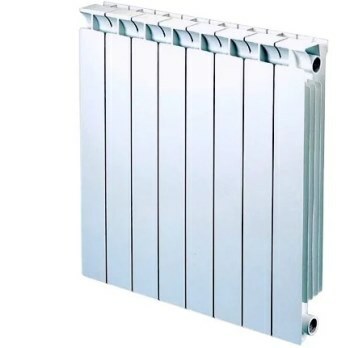
Classic sectional bimetallic radiator, consisting of 12 sections. Designed for wall mounting. Side connection requires 350 mm wiring. The maximum operating temperature is 110 degrees, the operating pressure can reach 35 bar, and the pressure test is a record 52.5 bar. Unfortunately, the mounting kit is not supplied with the radiator and must be purchased separately - this is, perhaps the only drawback of the model, apart from the rather high price of almost 12,000 rubles.
Price: ₽ 12 000
Global STYLE PLUS 350 x12
2. Bimetallic radiator Royal Thermo PianoForte 500 x10
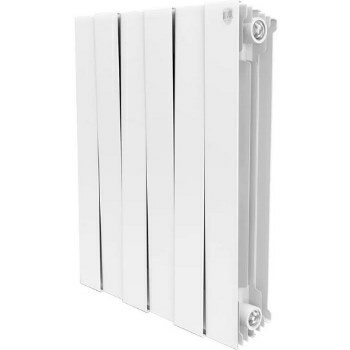
An extremely sleek and stylish designer radiator, available not only in classic white, but also in black and silver. The sectional structure consists of 10 elements, for which you will have to pay from 10,000 rubles. Wall mounting, lateral connection with a center distance of 500 mm. Heat transfer is quite solid for the modest dimensions of 1890 W maximum thermal power, which is enough for a room with an area of up to 18 square meters. Despite its dandy appearance, the radiator has very decent performance characteristics: it withstands the maximum operating temperature up to 110 degrees, operating pressure up to 30 bar, and pressure test up to 45 bar.
Price: ₽ 9 990
Royal Thermo PianoForte 500 x10
The best bimetallic sectional radiators with bottom connection
3. Bimetallic radiator Rifar Base Ventil 350 x8
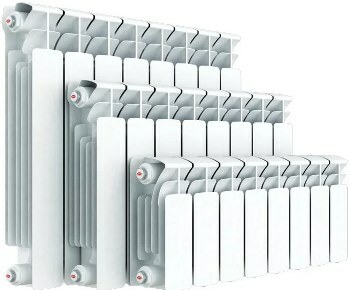
Sectional bimetallic radiator consisting of 8 elements. The power of the product is 1088 watts, which allows it to heat a room with an area of about 10 square meters. Wall-mounted construction with bottom connection (pipe diameter - ½ ", center-to-center distance - 50 mm). The radiator is characterized by resistance to high temperatures and water hammer, which is rare even for bimetallic models. The product is capable of withstanding a maximum operating temperature of up to 135 degrees, a maximum operating pressure of up to 20 bar and a pressure test of up to 30 bar. The kit includes a mounting kit. The price of the issue is around 7400 rubles.
Price: ₽ 7 400
Rifar Base Ventil 350 x8
4. Bimetallic radiator Rifar Base Ventil 500 x6
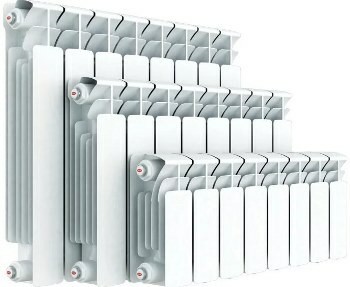
The price of this 6-section bimetallic radiator is about 6,000 rubles. For this money, we are offered a rather effective design with a bottom connection (connection diameter ½ ", center distance - 50 mm) and wall placement. The heat dissipation of the radiator is 1224 W, which gives a heated area of 12.1 square meters. The battery is unpretentious and durable. It is capable of withstanding a maximum operating temperature of up to 135 degrees, an operating pressure of up to 20 bar and pressure testing - up to 30 bar, which makes this radiator an excellent choice for an apartment in a building with a central heating.
Price: ₽ 6 150
Rifar Base Ventil 500 x6
Best Bimetal Tube Radiator
5. KZTO Elegant 1 250
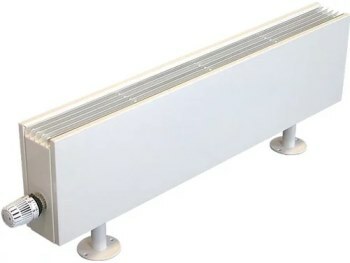
A compact tubular radiator that can be placed both on the wall and on the floor thanks to its versatile design. Modest dimensions (height - 250 mm and thickness 110 mm with a width of 500 to 2000 mm) allow you to install the product almost anywhere in the apartment). The battery is provided with a bottom connection with a center distance of 50 mm. The maximum operating temperature of the coolant should not exceed 130 degrees, the maximum operating pressure is 15 atmospheres, and the pressure test is 25 atmospheres. The price of the device starts from 7,600 rubles
Price: ₽ 7 600
KZTO Elegant 1 250
FAQ
Can a bimetallic battery be repaired?
Can. Most often, the most rational repair method is to replace the damaged section with a new one. To do this, you will need a special radiator disassembly wrench, gasket and sealant. It is better, easier and safer to entrust this work to a professional.
